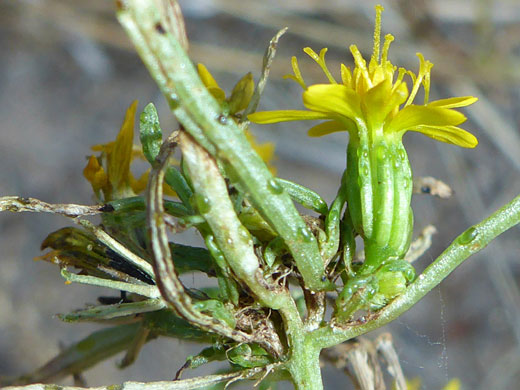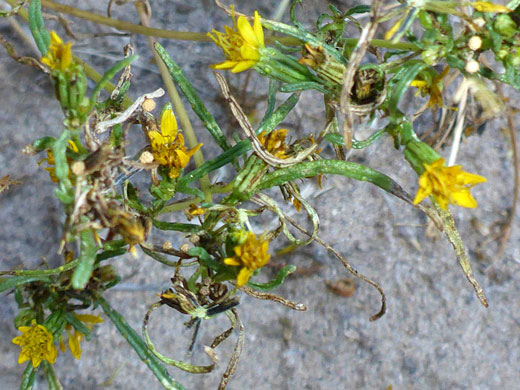Common name:
Chinchweed
Family:
Scientific name:
Pectis papposa
Main flower color:
Range:
Nevada and southern California, east to New Mexico and west Texas
Height:
Up to 2 feet
Habitat:
Desert flats, roadsides, grassland, dry woodland; up to 5,000 feet
Leaves:
Narrow, linear, hairless, up to 2.5 inches long, with small oil glands along the margins
Season:
June to December
Pectis papposa, an annual, forms rounded clumps up to 2 feet tall and wide, in desert areas of the West, from California to Texas. Plants have a distinct citrus scent, originating from oil glands on the leaves and phyllaries. All plant parts are hairless.
The inflorescence is a cyme; a flat-topped cluster, with the oldest flowerhead at the center. The green phyllaries are linear, in one series, all equal in length, with up to five oil glands near the tip and several pairs along the margins. There are (usually) eight yellow ray florets and up to 30 yellow disc florets.
Two varieties are var grandis with between 12 and 30 disc florets, inhabiting the Chihuahuan Desert, and var papposa, which has from six to 14 disc florets, and slightly shorter phyllaries; this is found in the Mojave and Sonoran Deserts.
The inflorescence is a cyme; a flat-topped cluster, with the oldest flowerhead at the center. The green phyllaries are linear, in one series, all equal in length, with up to five oil glands near the tip and several pairs along the margins. There are (usually) eight yellow ray florets and up to 30 yellow disc florets.
Two varieties are var grandis with between 12 and 30 disc florets, inhabiting the Chihuahuan Desert, and var papposa, which has from six to 14 disc florets, and slightly shorter phyllaries; this is found in the Mojave and Sonoran Deserts.
All Contents © Copyright The American Southwest | Comments and Questions | Contribute | Site Map






